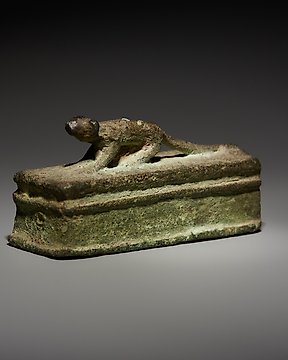
古埃及 青銅色 鼩鼱石棺。晚期,西元前 664 - 332 年7公分長。
編號 83777209

編號 83777209

Statue of the god Imhotep
- very rare -
CULTURE: Ancient Egypt
PERIOD: Late Period, 664 - 332 BC.
MATERIAL: Solid Bronze
DIMENSIONS: 2.6 cm height and 6 cm height with the stand.
PROVENANCE: Private collection, Paris, France. Collected since 60's-70's.
CONDITION: Intact.
DESCRIPTION:
Hero and god of medicine, Asclepios was worshiped in Greece and later in Rome under the name of Aesculapius. He was the son of Apollo and Coronis, and the father of Hygía (goddess of hygiene), Yaso (goddess of recovery from illness), Aceso (goddess of the healing process), Aegle (goddess of good health) and Panacea (goddess of healing). universal remedy). Likewise, his figure was associated with the Roman-Etruscan god Vediovis and the Egyptian Imhotep. According to mythological narratives, Aesculapius received his first medical teachings from his father, Apollo, although he was later instructed in the art of medicine by the centaur Chiron, and received secret knowledge from a serpent, a sacred animal in Greece and associated with to wisdom, healing and resurrection. Other versions narrate that, when he was ordered to bring Glaucus back to life, he was confined in a secret prison. There a snake climbed up his staff and the god, lost in thought, unconsciously hit the staff on the ground and killed the animal. A second snake then appeared, carrying a grass in its mouth; he placed it on the head of his dead sister and she was resurrected. Seeing this, Asclepios used the same plant to bring Glaucus back from the dead.
During his lifetime, Aesculapius became the most renowned physician, surpassing not only Chiron but also his own father, the divine Apollo, and was thereby awarded the power to bring the dead back to life. Hades, irritated to see that many of his subjects were taken from him, complained to his brother Zeus. Other sources explain instead that the King of Olympus was concerned that he teach the art of resurrection to other human beings. In any case, Zeus ended the life of Aesculapius with one of his fearsome thunderbolts, although, thanks to the intervention of Apollo, he finally granted him divinity and gave him a place on Olympus.
The rod of Aesculapius, the main iconographic attribute of the god, is one of the motifs of Classical Antiquity whose symbolism endures to this day. Although the serpent has a radically opposite meaning in Western Christian culture, for the Greeks it was a healing animal; its ability to shed its skin symbolized eternity and the restoration of life and health. The Rod of Asclepius is today a symbol of the medical profession on five continents, as well as of the World Health Organization.
The cult of Asclepius/Aesculapius dates back to Hellenistic Greece, and by the 5th century B.C. we already find it fully established, with the city of Epidaurus as its main center, although there were also important sanctuaries dedicated to the god on the island of Cos, Thessaly and Pergamon. In the year 420 B.C. A sanctuary was dedicated to him in Athens, located in the southern part of the Acropolis, next to a fountain. The sick believed that they could recover by sleeping in these temples, which in fact combined the functions of sanctuary and hospital and in which the Asclepius snakes (Zamenis longissimus) lived freely and were respected as sacred animals. His cult was continued by the Romans, and in fact Ovid, in his Metamorphoses, relates that during the plague epidemic of 293 B.C. Rome sent an embassy to Epidaurus to bring back Aesculapius, the only one capable of saving the city. The god then appeared in the form of a serpent and jumped into the sea.
Notes:
- The piece includes authenticity certificate.
- The piece includes Spanish Export License.
- The seller guarantees that he acquired this piece according to all national and international laws related to the ownership of cultural property. Provenance statement seen by Catawiki.